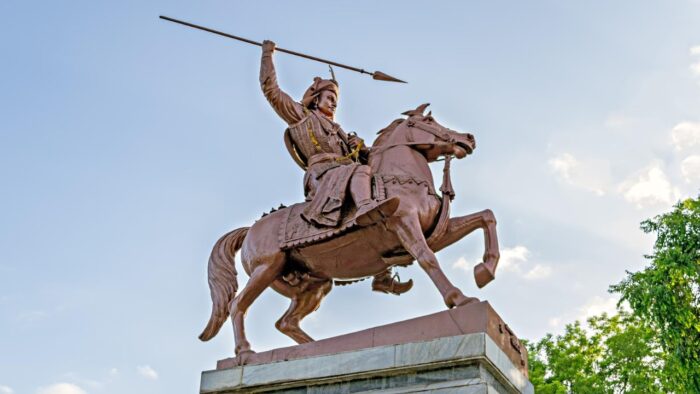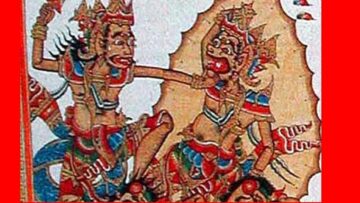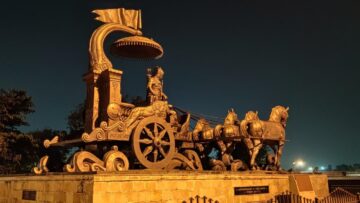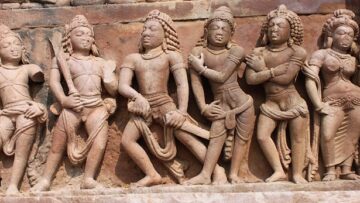Among the notable battles fought in India, the Battle of Palkhed, between Peswha Baji Rao I and the Nizam-ul-Mulk, would not readily spring to mind for many. Which is a pity, for several reasons.
While the three battles of Panipat – in 1526, 1556, and 1761, the battles of Talikota in 1565, Plassey in 1757, and Buxar in 1764, are rightly remembered for their pivotal impact on India’s history, the battle of Palkhed does not readily spring to mind. It should, for it is not only one of the notable battles in history, it also holds lessons that perhaps deserve a closer look.
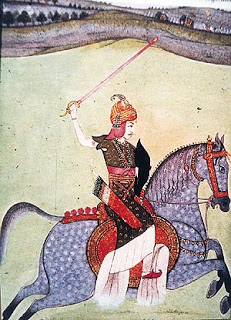
The battle of Palkhed was fought in 1728, between the armies of Baji Rao, the second Peshwa of Maharaj Shahu, and the Nizam. A brief look at the three principal players who were involved directly or indirectly reveals a fascinating if not turgid brew of politics and intrigue that had by then become the staple of the putrefying Mughal empire in Delhi.
The Maratha empire, in disarray in the years following Shivaji’s death – with the torture and murder of Sambhaji and the capture of Sambhaji’s infant son, Shahu – had started to rebuild itself after Aurangzeb’s death in 1707.
Shahu’s escape shortly after Aurangzeb’s death – after eighteen years in custody – gave the people hope and provided a rallying point for Shivaji loyalists like Senapati Dhanaji Jadhav, Khando Ballal, Diwan Balaji Vishwanath (and later the first Peshwa under Raja Shahu) and others.
While Shahu battled his aunt, Tara Bai – and her “specious arguments” – for the right to be considered as Shivaji’s true successor, the Marathas had also demanded from the Mughal king the rights to levy Chauth (an annual tax amounting to 25 per cent of revenue or produce – hence the name “chauth”) and Sardeshmukhi (a surcharge collected as tribute to the king) on the Deccan. In this endeavour they were hampered by some accidentally wise political manoeuvring by the Mughal sovereign.
The Last Days of Aurangzeb
Aurangzeb, in his last days, had come to the realization that a military victory over the Marathas was not possible, and had been exploring on what terms to “purchase peace.” His successors, for various reasons, had been unable to close the matter either.
Bahadur Shah had been clever – or indecisive – enough to throw the ball back into the Maratha court, when, in 1709, he asked Raja Shahu and Tara Bai to first resolve among themselves the issue as to who the Mughal sovereign would grant these demands. His refusal had the perhaps intended effect of reviving the civil war among the Marathas – especially between Shahu and Tara Bai, which had been slowly “flickering out.”
The Nizam would try identical tactics almost two decades later.
The second main actor in this saga was the Nizam. The Nizam-ul-Mulk, or Mir Qamar-ud-din as he was originally known, was born in 1671. Iranis, Turanis, Afghans, Indian Muslims, and Hindus – primarily Rajputs for long – among others formed the nobility in the Mughal court, with the Iranis and Turanis constituting two-thirds or more, and the Hindus less than ten percent.
In 1699 he was given a high rank as Chin Qilich Khan, and later the even more grandiose title of Nizam-ul-Mulk Bahadur Fateh Jang, and appointed Viceroy of the six subahs of the Deccan. He had risen to power after attracting Aurangzeb’s attention for his role in the capture of Wakinkhera in 1706. He had a fondness for heavy artillery, and in Aurangzeb’s words – “He has all the things that he should have, or rather that he should not have” – after the Mughal emperor had confiscated much of it after an inspection in 1707.
Backdrop
Despite offers of prime ministership, governorship of Khandesh, and the title of Khan-i-Dauran at Delhi at different times, the Nizam nurtured ambitions of carving out an independent sphere of influence for himself in the Deccan, independent of the Mughal emperor at Delhi, having seen and anticipated the coming decline of the Mughal empire.
The continuing claim of the Marathas of chauth and sardeshmukhi over these six provinces threatened to reduce his rule to being a mere titular head. This was not what his ambitions would permit. His ambitions however were tempered by a smart realization that he could not hope to succeed against the Marathas where Aurangzeb had failed. He bided his time.
He had stayed neutral in the succession wars between Aurangzeb’s sons, and had been suitably rewarded for that. While he spent some years in Delhi, “lured by the prime ministership of the empire”, he decided returned to the Deccan in 1724. However, even as he was en-route, he was stripped of his governorship of the Deccan, declared a rebel by the Mughal emperor, who ordered “officers and feudatories of the Deccan to treat the Nizam as a rebel.” It was in such circumstances that he had sought the help of the Marathas to defeat his rival, Mubariz Khan, at the battle at Shakarkharda on 1 October 1724.
The Nizam would also play an important role during the invasion of Nadir Shah, albeit in an indirect manner. It was his elevation to the title and post of “Mir Bakshi” by the Mughal emperor Muhammad Shah that would lead to a jealous Sa’adat Khan to instigate Nadir Shah into escalating his demands, and to finally march into Delhi, with Muhammad Shah as his escort and prisoner!
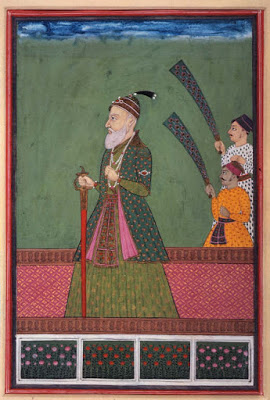
After Nadir Shah marched into Delhi in March 1739, he “publicly abused Nizam-ul-Mulk and Sa’adat Khan”, and asked for the twenty crore rupees he had demanded after the battle of Karnal. To save either their honour or themselves from the corporal punishment that Nadir Shah promised to unleash on both of them, the two – Nizam-ul-Mulk and Sa’adat Khan – allegedly entered into a suicide pact. “The Nizam did not abide by it, whereas Sa’adat Khan like a ‘true soldier drank a cup of poison and departed to the next world.’”
The state of the Mughal empire in the years following Aurangzeb’s death in 1707 had not been a happy one. The regular internecine and fratricidal bouts of succession between the Timurid scions were punctuated only by a steady and irreversible decline in the prestige and power of the dynasty. A sad succession of weak rulers and powerful puppeteers followed at the throne of Delhi, each titular with diminishing real authority over an empire whose effective boundaries continued to shrink, and where real authority was exercised more by the plotters and conspirers at the Delhi Durbar than the sovereign.
One such plotter had been Zu’lfiqar Khan, who had conspired to elevate Bahadur Shah’s eldest son, Jahandar Shah, to the throne. Soon thereafter, Zu’lfiqar Khan would meet his end when Jahandar Shah was deposed by his nephew, Farrukh-siyar (the son of Azim-ush-Shan, who was the younger brother of Jahandar Shah – who were the sons of Bahadur Shah), who would in turn take the help of two masters of intrigue – the Sayyid brothers; one a governor of Patna, and the other the governor of Allahabad.
Relations between Farrukh-siyar and the Sayyid brothers were, however, never cordial, and each continued to plot against the other. It was this plotting and counter-plotting that led Sayyid Hussain Ali to open negotiations with Peshwa Balaji Vishwanath Bhat. This may help explain why the Peshwa made very expansive demands, and why the Sayyid brother agreed. What remained now was the ratification of the agreement by Farrukh-siyar.
Meanwhile, the Nizam had arrived in Delhi from the Deccan – summoned by a panicky Farrukh-siyar who saw every last vestige of support he enjoyed at the court dissipate – thanks to the machinations of the Sayyid brothers. The Nizam, upon seeing the “precarious” position of the Mughal sovereign, decided to refrain from taking sides, yet again.
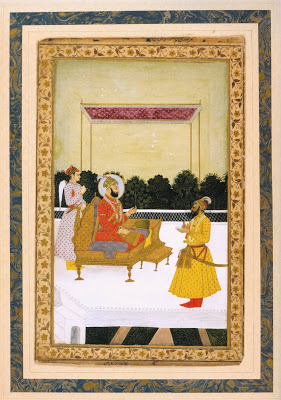
It would be worth re-emphasizing here that the Maratha terms to which Sayyid Hussain Ali had agreed were very, very generous indeed. Among many other things, the Marathas were granted the authority to collect Chauth from the six provinces of the Deccan – “Aurangabad, Berar, Khandesh, Golconda, and Bijapur (which included the whole of Karnataka, including the tributary states of Mysore, Trichinopoly and Tanjore)” – a massive area by any stretch.
The Sayyid brothers and the Nizam had not been on the same page when it came to dealing with the Marathas – since the Sayyid brothers “favoured conciliation of the Hindus, whereas the Turani leaders like the Nizam-ul-Mulk pressed for the revival of Aurangzeb’s methods of coercion and suppression of non-Muslim elements.” Also, “restrictions on the Hindus using palkis and Arabi and Iraqi horses imposed by Aurangzeb and continued by Bahadur Shah, were eased, and abolished altogether a few years later.” [Satish Sharma]
The Sayyid brothers saw in the agreement one stone to kill three birds – to win the military support of the Marathas if required in the future, to cut down to size the Nizam and his ambitions in the Deccan, and to ensure that the Mughal emperor stayed a mere titular with real power concentrated with the brothers.
For the time being however, the Nizam could do little but watch the Sayyid brothers’ machinations. The Mughal emperor, Farrukh-siyar, flatly refused to recognize this agreement with the “vile Marathas” that was sent to him for ratification.
Sayyid Hussain Ali marched into Delhi in February 1719, the Maratha army in tow.
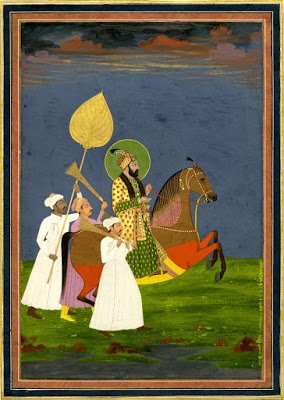
Farrukh-siyar was deposed and thrown into jail, where all manners of experiments of torture and murder were tried on him – from feeding him “bitter and over-salted dishes” to “slow poisoning”. He survived all these for some time, and finally met his end when executioners were sent who “strangled him to death in April 1719.” A quick succession of puppets followed the same year – Rafi’ud-Darajat, Shah Jahan II, and then Prince Roshan Akhtar (who would assume the name of Muhammad Shah). Muhammad Shah “Rangila” would enjoy a comparatively long reign of twenty-nine years, till his death in 1748.
This then was the backdrop against which the treaty between the Peshwa and the Mughal empire had been concluded in March 1719. Rafi’ud-Darajat had granted Peshwa Balaji Vishwanath the three farmans the Marathas had demanded, and who had returned to a hero’s welcome back home. Peshwa Balaji Vishwanath died a little over a year later, and his son, Baji Rao I, became the Peshwa, at the young age of twenty years, on 17 April, 1720.
The Canvas of Palkhed
This then was the canvas on which we now place the engagement of Palkhed.
As soon as the Nizam had gotten rid of the Mughal menace (Mubariz Khan) with the help of Raja Shahu, he “began his effort to free himself from the shackles of Maratha demand.”
Twice the Maratha forces “under the Pratinidhi and Peshwa marched into Karnatak (1725-26, 1726-27) only to be met by opposition from the Nizam’s officers.” He also responded enthusiastically to overtures from Shahu’s rival – Shambhuji – through the “renegade” Chandrasen Jadhav (the son of the legendary general), and the “joint force began to move ominously towards Maratha country.”
The final straw came when the Nizam disavowed the treaty between Raja Shahu and the Mughal emperor, “dismissed Shahu’s officers and asked him to submit his claims to his arbitration.” The Nizam also dropped hints to Shahu that he dismiss his Peshwa, Baji Rao.
The stage was set for a confrontation.
Shahu “hastily recalled his army from the south.” Peshwa Baji Rao arrived in May 1727, and on 1 August 1727, “orders for a general mobilisation were given.” As soon as the monsoon was over, the Maratha army marched towards Aurangabad.
There was a skirmish near Jalna, but the Peshwa avoided a full-blown battle and pushed northwards towards Burhanpur. He then took a westerly route towards Khandesh and then into Gujarat. All this while the Nizam – with his army, heavy artillery, food-grains to last the duration of the campaign, and zenana – kept in slow pursuit, unable to keep up with the much nimbler army of the Peshwa.
The frustrated Nizam abandoned his pursuit of Baji Rao, and instead turned his attention on Poona, with an aim of drawing out Baji Rao. “Quite a few outposts like Udapur, Avasari, Pabal, Khed, and Narayangarh surrendered.”
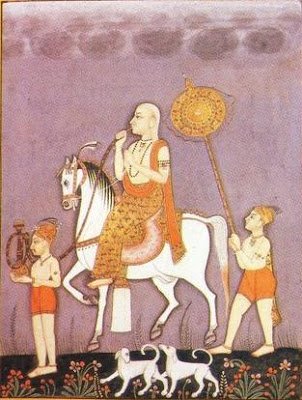
Shahu had to escape and take refuge in another fort. Baji Rao resisted “urgent calls” to rush back to defend Poona. Instead, the Nizam, while at Baramati, learned to his horror, that the “Peshwa had burst eastward through the Kasarbari Pass and was marching towards Aurangabad, the heart of the [Nizam’s] kingdom.”
The Nizam started in pursuit, but found his army cut off from all supplies to water near Palkhed on 25 February 1728. “Starved of food and water”, the Nizam’s army would not fight, though his heavy artillery was able to keep the Peshwa’s army at arm’s length.
Through the intercession of Iwaz Khan, the “Nizam sent the Peshwa a word of his miserable plight and his willingness to come to terms.” The Nizam’s army was only then allowed to move near the river. A treaty – generous to the Marathas – was entered into between the Peshwa and the Nizam at Mungi-Paithan on 6 March 1728. The Nizam agreed to every single term set by the Marathas, save one – the handover of Sambhaji (of Kolhapur).
A famous battle was thus concluded where there was no mass slaughter of soldiers on either side – that would take place 34 years later on the plains of Panipat, where arguably the largest number of deaths in a single day on a battlefield in history would be recorded.
This battle is remembered for it being a “masterpiece of strategic mobility”. It is useful to read what Field Marshall Montgomery had to write about this battle in his book:
Baji Rao’s army was a purely mounted force, armed only with sabre, lance and a bow in some units, and a round shield. There was a spare horse for every two men. The Marathas moved unencumbered by artillery, baggage, or even handguns and defensive armour. The lightly equipped Marathas moved with great rapidity, avoiding the main towns and fortresses, living off the country, burning and plundering. … The Nizam for a time pursued them but was bewildered by the swift and unpredictable movements of the enemy, and his men became exhausted.
Assessment
While the battle of Palkhed is fascinating in its own right as an example of the military brilliance of Baji Rao, I am drawn to at least three other facets of this engagement.
First, it’s been an oft-repeated charge against medieval Indian kingdoms that they stuck for too long to using slow-moving, lumbering elephants in their armies, which were woefully ill-prepared for battles fought with guns and modern weaponry. While that may well be true as a broad generalization, the battle of Palkhed serves as a striking counter-example to this dogma.
Baji Rao’s army travelled fast, and they travelled light. If anyone was slow-moving and lumbering, it was the Nizam’s army. Second, the guerrilla tactics so famously perfected by Shivaji had neither been forgotten nor allowed to rust. Institutional memory was intact.
Baji Rao made up for travelling light by “living off the country.” A war had to be fought to be won, and not by constraining yourself with contrived and utopian rules of chivalry. Where compromises needed to be made, they were made. Baji Rao understood that.
Self-made rules of war in India have often dictated that the desired end of victory be sacrificed at the altar of rather juvenile infatuation with proving one’s worth by engaging in mortal combat.
Baji Rao did not engage the Nizam’s army; even when it made way for and started plundering the areas around Poona – utopian notions of chivalry would have demanded that Baji Rao stride into Poona, into the well-laid trap set by the Nizam, and perish in a blaze of glory.
He instead counter-attacked at Aurangabad – going after the Nizam’s vulnerability, and even then shrewdly blockaded the Nizam’s army, starving it into surrendering. Glory was attained in getting the Nizam to the negotiating table, and getting every single concession they wanted. Glory did not lie in body counts.
Yet, lessons from these successes stayed isolated, could not be replicated, nor adapted elsewhere by Indian kingdoms, not even by the Marathas themselves. Worse, not even by Baji Rao, for the recidivist Nizam would try again to crush the Marathas a few years later, and meet yet again a similar fate!
The Marathas however lost out, steadily, to the English, and by 1818 had ceased to exist as an imperial power.
While an investigation into the causes of the decline of Indian kingdoms and their capitulation to the English has been well-examined by historians for well over a century, I would submit that while the English brought a clear-headed ends-justify-the-means attitude to domination, their cause was undeniably helped by that one ace that the English were undeniably superior to everyone else in the world – bureaucracy.
Bureaucracy – the most efficient form of organization that allowed for as efficient a transmission of institutional knowledge as possible. There is much that can be written here, but for the time being I want to leave this particular topic as-is, with the promise of delving and digging into it in some depth in a future piece.
In conclusion, let’s see how this battle has been described elsewhere – elsewhere as in other than in Volume 8 of the “History and Culture of the Indian People” series.
Battle of Palkhed in Textbooks
I present two examples.
This is the entire description of the battle, its background, relevance, and importance, from a history textbook prescribed for class IX students under the ICSE curriculum:
Baji Rao I could not tolerate the activities of the Nizam. He, therefore, besieged Nizam and his army at Palkhed in 1728 A.D. The Nizam was reduced to a dire state and besought Baji Rao I for a treaty of peace.[pgs 278-79, “Indian History and Culture”, Kaley, Bhandari, and Sushila; Inter University Press, 1986]
The second example is from “Medieval India: From Sultanat to the Mughals – Part Two”, written by Satish Chandra, and published by Har-Anand Publications:
Baji Rao decided on immediate war, rejecting the peace overtures made by Nizam-ul-Mulk who had no real desire for war. After a brief but brilliant campaign, Baji Rao brought Nizam-ul-Mulk to bay at Palkhed.
Satish Chandra, along with S Gopal, Romila Thapar, and Bipan Chandra helped guide, in 1970, the launch of the Centre for Historical Studies at the School of Social Sciences at the Jawaharlal Nehru University.
The perversion of Indian history by those claiming to be its historians has been done not by outright falsification or omission of facts – because those would be easy to catch – but by a more devastating combination of distortions and trivializations.
History written by these eminent historians abounds with such instances – these are but two, and that on a battle as important as Palkhed.
Reference:
I have adapted this account from “Volume VIII – The Maratha Supremacy” of the magnum opus – “The History and Culture of the Indian People”, General Editor R.C. Majumdar, published by Bharatiya Vidya Bhavan, Second Edition, 1991.
Image Credit: Picxy.com/lalam
(This article was published by IndiaFacts in 2015)
Disclaimer: The opinions expressed in this article belong to the author. Indic Today is neither responsible nor liable for the accuracy, completeness, suitability, or validity of any information in the article.

